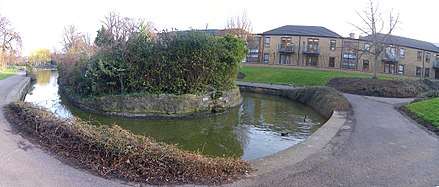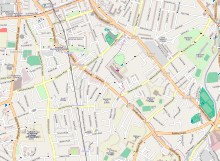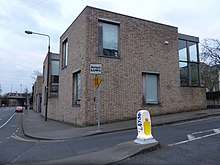Ranelagh
Ranelagh (/ˈrænələ/ RAN-ə-lə, locally pronounced /ˈrɛnələ/; Irish: Raghnallach) is a residential area and urban village on the south side of Dublin, Ireland in the postal district of Dublin 6.


History
The district was originally a village known as Cullenswood [1] just outside Dublin, surrounded by landed estates.
On Easter Monday in 1207, a celebrating group of English inhabitants of Dublin were attacked here by Irish raiders from county Wicklow. Three hundred people were said to have been killed.[2]
In the early years of the Irish Confederate Wars (1641–1649) the area was the scene of skirmishes culminating in the Battle of Rathmines in August 1649. After the Irish united with the Royalists against the Parliamentarians, an attempt was made to take Dublin. Their army under Ormonde was defeated, many of them killed, and the place where they fell (mainly between Rathmines and Ranelagh) was known for a long time as the Bloody Fields.[3]
The area was incorporated into the expanding city in the 19th century, after which massive development took place.[4] The locality became known as Ranelagh when a popular entertainment venue (now a public park) was established about 1770 and named Ranelagh Gardens after a similar venture of the same name in Chelsea, London.[5] (The model and the name were also copied in other cities, including Liverpool, New York and Paris).[6] The original Ranelagh Gardens in Chelsea was built on the site of Ranelagh House, the London home of the Jones family, who took their title (Earls of Ranelagh) from lands in County Wicklow that had belonged to Fiach McHugh O'Byrne[7] sometimes described as Lord Ranelagh, because he was head of the Gabhal Ragnaill branch of the O'Byrne clan.[8]
In 1785, only two years after the first manned flight, Richard Crosbie successfully flew in a hot air balloon from Ranelagh Gardens to Clontarf.[9] The 225th anniversary of his flight was commemorated with a balloon flight from the same gardens on 23 January 2010 although due to adverse weather the balloon did not take off.[10]
Geography

The name Ranelagh applies to many geographical features. The stretch of road joining Sandford Road (which begins at the corner of Anna Villa) to Ranelagh Road (which begins at the railway bridge) is known as Ranelagh or Ranelagh Village. The whole surrounding area is also popularly known as Ranelagh, stretching from Charlemont Bridge on the Grand Canal at the northern end of Ranelagh Road down to the junction with Milltown Road at the southern end of Sandford Road, and from Leeson Street to the East towards Rathmines to the West. At the centre of Ranelagh is "Ranelagh Triangle", semi-officially "the Angle", which is the junction of Ranelagh Village and Charleston Road at Field's Terrace. Nearby restaurant "Tribeca" references these geographical features (i.e., Tri-angle Be-low Ca-nal). To the North of the Triangle is the "Hill Area" of Ranelagh, which was the scene of Lee Dunne's novel, "Goodbye to the Hill". Ranelagh contains many fine Victorian streets such as those surrounding Mount Pleasant Square.
The townlands of Ranelagh North and Ranelagh South are in the civil parish of St. Peter's and in the barony of Uppercross. They are bounded on the north by Harcourt Road and Adelaide Road, on the east by Sussex Road and an old irregular boundary from there to Chelmsford Road, on the south by Chelmsford Road, Ranelagh Village, Charleston Road, Oakley Road and Dunville Avenue, and on the west by Beechwood Park, Belgrave Square East, Mountpleasant Avenue Upper, Bessborough Parade, Rathmines Road Lower and Richmond Street South. The area popularly known today as Ranelagh also includes parts of the adjoining townlands of Cullenswood, Sallymount and Milltown.
Electoral area
Ranelagh is in the Local Electoral Area of Rathgar-Rathmines with effect from May 2014, formerly Pembroke/Rathmines. It is located in the Dáil Constituency of Dublin Bay South with effect from the 2016 General Election, formerly Dublin South-East.
Education

There are several primary and secondary schools in the area.
Scoil Bhríde, founded in 1917, was the first gaelscoil (Irish-language school) in Ireland.[11]
Lios na nÓg, another gaelscoil, is located in Cullenswood House on Oakley Road, where St. Enda's School (Scoil Éanna) was set up by Patrick Pearse in 1908. This was the first school in Ireland where pupils were taught in both Irish and English. St. Enda's school then moved to Rathfarnham in 1912 leaving the school building, Cullenswood House, unoccupied. In 1998, Lios na nÓg moved in and the school went under a major refurbishment over the period 2008-'09.
The Ranelagh Multi-Denominational School, is another primary school established in September 1988, which is located on the main Ranelagh road close to the Luas stop. It is on the site of the old St. Columba's national school, which was donated to RMDSA by the Church of Ireland. The school won many awards for the architecture of the building, built in the late 1990s.
Other primary schools in the area include Sandford National, located close to Gonzaga College.
Secondary schools include Gonzaga College for boys and Sandford Park School.
Culture
Lee Dunne's novel Goodbye to the Hill is set in Ranelagh.
The cover picture of John McGahern's The Pornographer is of Mount Pleasant Square.
In March 2013, Lenny Abrahamson, Irish film and television director, filmed part of his movie "Frank" on Cowper Gardens and Park Drive of Ranelagh.
Sport
Gaelic Football
Founded in 2003, Ranelagh Gaels first commenced competitive action in 2004. They recently topped the league in Division 9 and now competed in League 8, and grade C in the Dublin county championship. They play their home games in Bushy Park in Terenure, and train in UCD. They have recently started a ladies team, which will compete in the league in 2010. The Ladies won the Dublin Junior E Championship in 2010.[12] The first Championship the club has ever won.
Transport
The Luas Green Line has two stops in the Ranelagh area: Ranelagh/Raghnallach (on Ranelagh Road) and Beechwood (on Dunville Avenue), built on the site of the former Ranelagh railway station on the Harcourt Street railway line (the station opened as Ranelagh & Rathmines on 16 July 1896, was renamed Ranelagh in 1921 and finally closed on 1 January 1959).[13]
The 11 and 18 routes pass through Ranelagh.[14]
The Dublin Metro (Metrolink) was expected to upgrade Ranelagh's existing Luas stop to a metro station,[15] but, as a result of the portal of the tunnel being moved south to just north of Beechwood, the Metro will no longer stop at Ranelagh. It will serve Charlemont, immediately north of Ranelagh when Phase 1 of Metrolink opens and Beechwood when Phase 2 opens.[16]
People
Notable people associated with Ranelagh include the following:
- Wilfrid Brambell (1912–85), film and television actor best known for his role in the British television series Steptoe and Son was raised on Edenvale Road.
- Maeve Brennan (1917–93), short story writer and long-time journalist with The New Yorker magazine, was born and raised in Ranelagh; she set the majority of her fiction in a terraced house based on her home at 48 Cherryfield Avenue.[17]
- Robert Briscoe (1894-1969), former Lord Mayor of Dublin and TD was born on Lower Beechwood Avenue, Ranelagh.
- Helen Dillon (1940- ), one of Ireland's most famous gardeners, who lived on Sandford Road from 1972 to 2016, operating one of the country's most visited gardens
- Ken Doherty (1969- ), Former World snooker champion, is from the area and used to practice in local snooker club, Jason's (demolished in 2012).
- Garret FitzGerald (1926-2011), who was Taoiseach (Prime Minister) of Ireland twice in the 1980s and Fine Gael Leader 1977-87, lived the last years of his life at Anna Villa in Ranelagh.
- Eamon Dunphy (1945- ), Irish media personality, broadcaster, author, sports pundit and former professional footballer, lives in Ranelagh.
- Eleanor Knott (1886-1975), Irish language scholar, was born in 2 Sallymount Terrace Ranelagh, where she lived much of her life.
- Seosamh Laoide (1865-1939), Irish language scholar was born 7 Annaville Lower in Ranelagh.
- Nell McCafferty (1944- ), Northern Irish civil rights campaigner and journalist, has lived in Ranelagh for many years.
- Seán MacEntee (1889-1984), IRA leader, Fianna Fáil politician and government minister lived in Marlborough Road
- Máire Mhac an tSaoi (1922-), noted Irish language poet and scholar, lived in Marlborough Road.
- Michael McDowell (1951- ), Senator, Former Tánaiste and Minister for Justice and Leader of the Progressive Democrats, lives in Ranelagh off the triangle.
- Eamon Morrissey (1943- ), actor, grew up in Ranelagh, coincidentally in the same house as Maeve Brennan, 48 Cherryfield Avenue, and has written and performed a play about the property, "Maeve's House".[18]
- Michael Mulcahy (1960- ), Former Fianna Fáil TD, lives in the Beechwood area of Ranelagh.
- John Mulholland (1962- ), editor of the UK newspaper The Observer, grew up in Ranelagh.
- Deirdre O'Connor (1951-1999), architect, first female president of the Architectural Association of Ireland, born in Ranelagh.
- Peadar O'Donnell (1893-1986), Irish republican and socialist revolutionary, lived in 39 Marlborough Road for many years.
- Maureen O'Hara (1920-2015), Hollywood actress, grew up at 32 Upper Beechwood Avenue.[19]
- Brendan O'Reilly (1929-2001), Olympian, RTÉ commentator, journalist, singer, songwriter, actor, author, lived in Ranelagh for many years until his death.
- Pádraig Pearse (1879-1916) lived in Ranelagh until he moved his school to Rathfarnham*Eamon Ryan (1963- ), Leader of the Green Party, lived in the Ashfield Road area for a time.
- Mary Robinson (1944- ), Former President of Ireland and UN High Commissioner was a resident of the area on Sandford Rd.
- Bernie Tormé (1952-2019), rock guitarist, singer, songwriter
- Jack B. Yeats (1871-1957), noted Irish artist and brother of WB Yeats, lived in 61 Marlborough Road, Ranelagh.
- Simone Rocha (1986-), the Irish fashion designer's family home is in Ranelagh.
References
- Curtis, M (2012) Rathmines, The History Press Ireland, Dublin, p 25; Wren, Jimmy (1987) The Villages of Dublin, Tomar, Dublin
- Ware, Sir James (1705) The Antiquities and History of Ireland, A Crook, Dublin p 41
- F. Elrington Ball: A History of the County Dublin. 1903. Part II. page 103 et passim
- Curtis, M (2012), p 60
- Helen, Lloyd (2011) Ranelagh Gardens: A Comparative Case Study of Pleasure Gardens in 18th century Dublin and London, School of Architecture, University College Dublin
- V.L. Redway, "Handel in Colonial and Post-Colonial America (To 1820)" The Musical Quarterly 1935; Caldwell, Mark (2005). New York Night: The Mystique and Its History. (New York: Scribner's) p. 44. Layton-Jones, Katy; Lee, Robert (2008), Places of Health and Amusement, Swindon: English Heritage, pp. 4–6
- O'Brien, Conor (2000) Feagh McHugh O’Byrne, History Ireland, Vol 8 No 1
- Kelly, Deirdre (1995) Four Roads to Dublin: A History of Rathmines, Ranelagh and Leeson Street, O'Brien Press, Dublin p.60; Peter, Ada (1907) Sketches of Old Dublin, Sealy Briars and Walker, Dublin.
- Rice, Eoghan (2006-12-17). "First Irishman to take to the skies to be honoured". Archived from the original on 2007-11-22. Retrieved 2007-04-09.
- Ranelagh Arts Festival Archived 2011-07-27 at the Wayback Machine
- Scoil Bhríde
- Well Whooley God! (Sep 9, 2010) Ranelagh Gaels 2-9 Scoil Ui Chonaill 2-7
- "Rathmines and Ranelagh station" (PDF). Railscot - Irish Railways. Retrieved 2007-11-23.
- "Timetables - Dublin Bus - Ranelagh". www.dublinbus.ie. Retrieved 2018-08-29.
- https://static.rasset.ie/documents/news/2018/03/metrolink-nta-tii-public-consultation-document.pdf
- https://www.metrolink.ie/assets/downloads/ConstructabilityReportGreenLineClosure.pdf
- https://www.irishtimes.com/culture/books/the-springs-of-affection-by-maeve-brennan-review-irresistible-stories-1.2671940
- https://www.abbeytheatre.ie/whats_on/event/maeves-house1/
- http://ranelaghrooms.com/maureen-ohara-room/